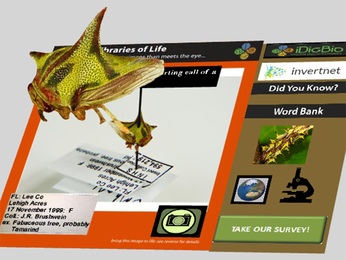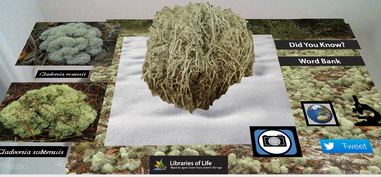About the Libraries of life project

Augmented reality specimen cards serve as an exciting, new education and outreach tool that aim to promote engagement and accessibility to biodiversity specimens, which largely remain hidden from public view in U.S. museums, universities, field stations, and other institutions. The Libraries of Life team is a collaboration between the U.S. National Science Foundation's National Resource for Advancing Digitization of Biodiversity Collections (iDigBio) and a growing number of Thematic Collections Networks (TCNs). iDigBio and the TCNs are focused on creating digital, web-deployed information about the nation's biodiversity specimens to benefit science and society. Arizona State University's Anne Basham, founder of ExplorMor Labs and Florida State University's Austin Mast (Department of Biological Science and iDigBio) lead development of the cards and app within iDigBio’s Augmented Reality for Public Outreach (ARPEO) Working Group. Other members of ARPEO are acknowledged here.
ARPEO (Augmented Reality for Public Education/Outreach) Goals and Objectives
1. Developing a collaborative inter-institutional 3-D portal for the scientific and educational exchange of specimen-based digital assets and their data in an open environment. To establish standards in creating metadata associated with a 3-D repository.
2. To redefine 3-D so that it is inclusive of what the greater scientific community considers “digitization” which is still largely focused on 2-D.
3. Establish best practices for making AR content accessible to diverse audiences and platforms that will allow teachers to easily and quickly implement AR content in their classrooms at no cost.
4. To offer professional development for teachers in the use and integration of AR content that will align with the Common Core standards.
5. To establish best practices in assessing learning impact as a result of engaging with AR content.
6. The potential of further institutional collaborations in the co-development of 3-D specimens and learning resources in serving broader impacts.
7. To continue to develop tasks that best align with the objectives of the ADBC (Advancing Digitization of Biodiversity Collections) community and NIBA's Goal 6 which states the importance in advancing specimen-based tools and the use of new technologies in formal and informal educational settings.
A special thanks to Becky Hansis-O'Neill with the Idaho Natural History Museum and team at the Idaho Virtualization Lab for their contributions to the above.

